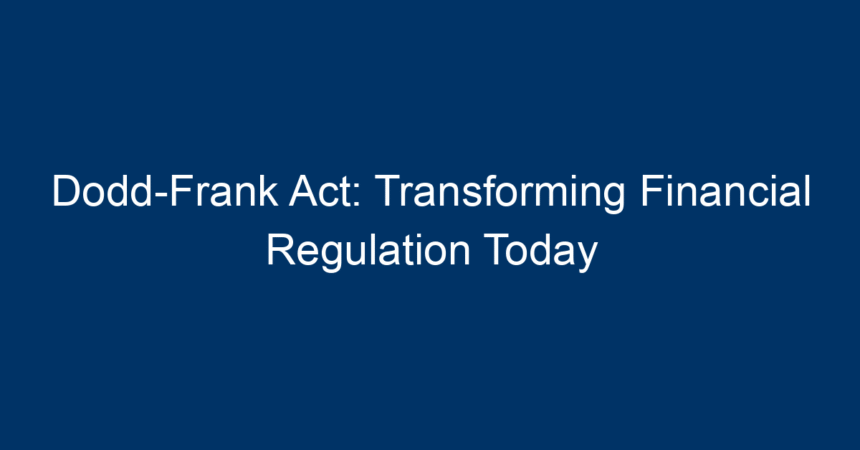The Dodd-Frank Wall Street Reform and Consumer Protection Act, commonly known as the Dodd-Frank Act, was signed into law on July 21, 2010, in response to the financial crisis of 2007-2008. This extensive legislation fundamentally reshaped the landscape of financial regulation in the United States. Aimed at preventing the reckless behavior that led to the Great Recession, the Act introduced measures to increase transparency, reduce risks, and protect consumers. In this article, we will explore the Dodd-Frank Act’s key features, its impact on financial institutions and consumers, and the implications for the future of financial regulation.
Understanding the Dodd-Frank Act
Background of the Dodd-Frank Act
The Dodd-Frank Act emerged from a period of financial turmoil that severely damaged the global economy. The collapse of major financial institutions triggered a wave of foreclosures and led to millions losing their jobs. To prevent a recurrence of such a catastrophic failure, Congress enacted the Dodd-Frank Act. Sponsored by Senator Chris Dodd and Representative Barney Frank, the legislation aimed to create a more stable and secure financial system.
Key Goals of the Dodd-Frank Act
The Dodd-Frank Act has several primary objectives:
-
Enhancing Financial Stability: By establishing regulatory oversight over large financial institutions, the Act aims to minimize the risk of systemic failures.
-
Consumer Protection: The Act created the Consumer Financial Protection Bureau (CFPB) to oversee financial products and services to ensure fairness and transparency.
-
Increasing Transparency: The Dodd-Frank Act mandates greater disclosure from financial institutions, particularly regarding derivative transactions.
- Regulating Risky Financial Activities: The Act seeks to regulate practices deemed unsafe, such as proprietary trading and certain investment activities conducted by banks.
Major Components of the Dodd-Frank Act
Creation of the Consumer Financial Protection Bureau (CFPB)
One of the cornerstone achievements of the Dodd-Frank Act is the establishment of the CFPB. This agency was created to empower consumers with information and protect them from predatory lending practices. The CFPB regulates various financial products, including mortgages, credit cards, and student loans, ensuring consumers have access to clear and relevant information.
Volcker Rule: Limiting Risky Trading
The Dodd-Frank Act introduced the Volcker Rule, named after former Federal Reserve Chairman Paul Volcker. This rule restricts banks from engaging in proprietary trading—essentially, speculative trading for their own profit rather than on behalf of customers. By limiting these activities, the Volcker Rule aims to reduce risk-taking behaviors that contributed to the financial crisis.
Stress Tests for Banks
Under the Dodd-Frank Act, large financial institutions are required to undergo regular stress tests. These tests assess how banks can withstand economic downturns and maintain adequate capital levels. By regularly evaluating the financial health of these institutions, regulators can identify potential vulnerabilities and act before they escalate into crises.
Derivative Regulation
A significant aspect of the Dodd-Frank Act was the regulation of derivatives—financial contracts whose value depends on the price of an underlying asset. The Act mandates that many derivatives be traded on exchanges, increasing transparency and reducing counterparty risk. This requirement aims to make the derivative market less opaque, decreasing the likelihood of a repeat of the 2008 crisis.
Financial Stability Oversight Council (FSOC)
The Dodd-Frank Act established the FSOC to identify risks to financial stability posed by large financial institutions. The council assesses systemic risks and can designate certain non-bank financial institutions as "systemically important," subjecting them to stricter oversight and regulation.
Impact of the Dodd-Frank Act on Financial Institutions
Effects on Major Banks
The Dodd-Frank Act imposed rigorous regulatory scrutiny on large banks known as "too big to fail." Many financial institutions have had to adapt their business models to comply with new regulations. This scrutiny has led to increased costs for banks as they invest in compliance procedures, ultimately impacting their profitability.
Changes in Lending Practices
With the creation of the CFPB and the enforcement of consumer protection regulations, lending practices have changed significantly. Banks are now more cautious about approving loans, especially to high-risk borrowers. While this enhances consumer protection, it may also limit access to credit for some individuals.
Focus on Risk Management
The Dodd-Frank Act has heightened the focus on risk management practices within financial institutions. Senior executives must now be accountable for their actions, and risk management frameworks must be robust and transparent. This cultural shift aims to foster accountability and ensure long-term stability in financial institutions.
The Dodd-Frank Act and Consumer Protection
Enhanced Consumer Rights
The Dodd-Frank Act aims to empower consumers by providing clear information about financial products. The CFPB ensures that consumers understand the terms of mortgages, credit cards, and other financial products, reducing the risk of predatory lending practices.
Impact on Affiliate Relationships
The Act also addresses problematic affiliate relationships between banks and third-party lenders. By prohibiting certain practices, the Dodd-Frank Act helps ensure consumers receive fair treatment, regardless of where they obtain financial products or services.
Financial Education Initiatives
In addition to regulatory measures, the Dodd-Frank Act has spurred initiatives aimed at increasing financial literacy among consumers. By fostering knowledge and understanding of financial products, the Act promotes responsible borrowing and financial decision-making.
Ongoing Challenges and Revisions to the Dodd-Frank Act
Regulatory Rollbacks
Despite its far-reaching aims, the Dodd-Frank Act has faced challenges over the years, including attempts to roll back regulations. Certain provisions have been eased, particularly for smaller banks, as some lawmakers argue that these restrictions stifle lending and economic growth.
Balancing Regulation and Economic Growth
The financial industry continues to seek a balanced approach to regulation. Advocates for less regulation argue that excessive compliance costs can hinder growth and innovation. Finding the right balance between consumer protection and fostering economic growth remains a critical conversation.
Conclusion: The Future of the Dodd-Frank Act
The Dodd-Frank Act was a monumental response to the financial crisis, introducing essential reforms to protect consumers and promote financial stability. While its implementation has encountered challenges, its core principles continue to guide contemporary discussions about financial regulation.
Actionable Insights
-
Stay Informed: Consumers and financial professionals alike should stay updated on the evolving regulations under the Dodd-Frank Act and adapt to changes in the financial landscape.
-
Prioritize Compliance: Financial institutions must prioritize compliance with the Dodd-Frank Act to avoid penalties and enhance their reputations.
- Promote Financial Literacy: Financial education initiatives should be embraced to empower consumers and reduce the likelihood of poor financial decisions.
In summary, the Dodd-Frank Act has successfully reshaped the landscape of financial regulation, promoting greater accountability and stability in the banking system. Its evolution and impact will continue to unfold, shaping the future of financial regulation in the years to come.




